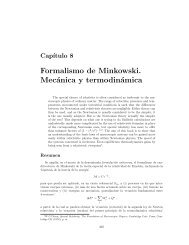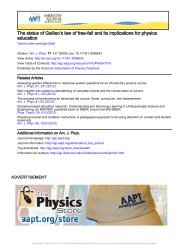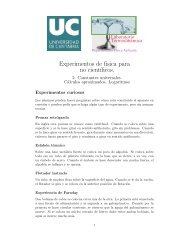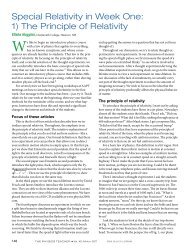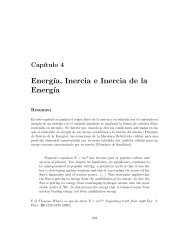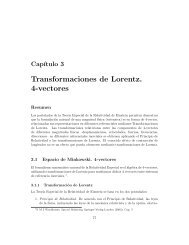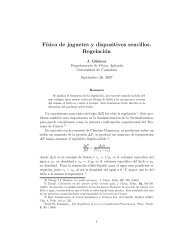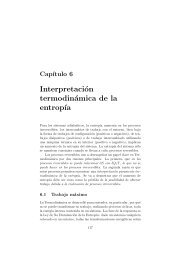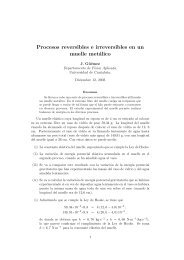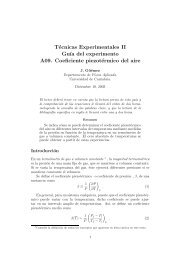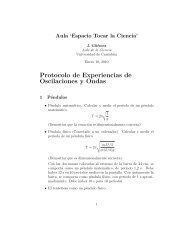Energy and the Confused Student III: Language - Loreto-Unican
Energy and the Confused Student III: Language - Loreto-Unican
Energy and the Confused Student III: Language - Loreto-Unican
- No tags were found...
Create successful ePaper yourself
Turn your PDF publications into a flip-book with our unique Google optimized e-Paper software.
Potential <strong>Energy</strong>In discussions of potential energy, a commonmisleading practice is to use a phrase such as <strong>the</strong> “potentialenergy of <strong>the</strong> ball,” in which potential energyis associated with an object ra<strong>the</strong>r than with a systemof two or more interacting objects. This is misleadingconceptually <strong>and</strong> ignores <strong>the</strong> importance of <strong>the</strong> system,as discussed in <strong>the</strong> second article in this series. 1 Itis important to stress that potential energy is a propertyof a system, not an object. It is associated with aforce that acts between members of <strong>the</strong> system so itcannot be associated with one member only—a singleobject cannot possess potential energy. 2 Therefore, <strong>the</strong>better phrase for gravitational potential energy is <strong>the</strong>“potential energy of <strong>the</strong> ball-Earth system.”Ano<strong>the</strong>r common misleading statement is to saythat potential energy is related to <strong>the</strong> positions ofobjects that are interacting within a system. This isa claim that causes little or no trouble in simple mechanicsproblems but must be revised later on when<strong>the</strong> student studies electromagnetism. Imagine anelectric dipole in an electric field or a magnetic dipolein a magnetic field, ei<strong>the</strong>r of which can be rotatedwithout a change in position. Even though <strong>the</strong> positionof <strong>the</strong> center of <strong>the</strong> rotating dipole remainsunchanged, <strong>the</strong> potential energy of <strong>the</strong> dipole–fieldsystem changes. This change is caused by a change in<strong>the</strong> orientation of <strong>the</strong> dipole, not a change in position.Consequently, it sets <strong>the</strong> stage for future possibilitiesto discuss in mechanics that potential energy is associatedwith <strong>the</strong> configuration of interacting objects in asystem. This allows for changes in both position <strong>and</strong>orientation.In a related issue, a common statement in mechanicsis that <strong>the</strong> “potential energy is zero at <strong>the</strong> bottom of<strong>the</strong> ramp.” This suggests that potential energy is likea field, having a unique value at all points in space. Itis more proper to say that <strong>the</strong> “potential energy is zerofor <strong>the</strong> configuration of <strong>the</strong> system in which <strong>the</strong> car isat <strong>the</strong> bottom of <strong>the</strong> ramp.”HeatMoving to <strong>the</strong>rmodynamics, we find <strong>the</strong> mostmisused physics word in popular language—heat. Itis important to stress that physicists use this word torefer to (1) a process by which energy is transferred <strong>and</strong>(2) <strong>the</strong> amount of energy transferred by this process,normally denoted as Q. It is not <strong>the</strong> entity that is beingtransferred (heat is not transferred; it is energy that istransferred) <strong>and</strong>, even worse, it is not <strong>the</strong> energy contentof a system with a temperature (correctly describedas internal energy). Romer 3 claims that heat shouldnot be used as a noun. While I agree with <strong>the</strong> spirit ofusing <strong>the</strong> word heat correctly, I disagree that heat is nota noun. Heat is indeed a noun, but it is <strong>the</strong> name of aprocess, not <strong>the</strong> name of what is transferred. Bauman 4has also discussed <strong>the</strong> use of <strong>the</strong> word heat <strong>and</strong> its interpretationas temperature <strong>and</strong> internal energy.Consider some phrases used in common language:“heat transfer,” “flow of heat,” <strong>and</strong> “<strong>the</strong> heat radiatedoutward.” These phrases refer to a transfer of energybut represent incorrect uses of <strong>the</strong> word heat. Thephrases can be tested by substituting <strong>the</strong> words “energytransfer” for “heat.” Each phrase sounds awkwardor redundant when this is done. For example, “heattransfer” becomes “energy transfer transfer.” O<strong>the</strong>rcommon phrases include “<strong>the</strong> heat of <strong>the</strong> day” <strong>and</strong>“too much heat in <strong>the</strong> air.” In <strong>the</strong>se uses, heat is beingused to represent temperature. Ano<strong>the</strong>r commonstatement is “heat rises.” In this case, heat is used tomean warm air!Barrow 5 makes a radical suggestion that <strong>the</strong> wordswork <strong>and</strong> heat should “vanish from <strong>the</strong> <strong>the</strong>rmodynamicsscene.” He stresses that <strong>the</strong>rmodynamics shouldfocus on energy, <strong>and</strong> not on work <strong>and</strong> heat. I wholeheartedlyagree that <strong>the</strong>rmodynamics should focus onenergy; in fact, all branches of physics should focuson energy as <strong>the</strong> entity that is being transferred. Idisagree, however, that we should rid ourselves of <strong>the</strong>words work <strong>and</strong> heat. I think students clearly see a differencebetween (1) applying a force on a system <strong>and</strong>(2) placing a cold system in a warm environment, <strong>and</strong>we need words to differentiate <strong>the</strong>se two very differentsituations.While it is not likely that we can turn societyaround in its use of <strong>the</strong> word heat, we can strive tohave a fraction of <strong>the</strong> population, our students, using<strong>the</strong> word correctly. For <strong>the</strong> case in which energymoves between a system at one temperature <strong>and</strong> itssurroundings at a different temperature, <strong>the</strong> processthat occurs is “energy transfer by heat.” I dislike <strong>the</strong>slightly different phrasing “energy transfer in <strong>the</strong> formof heat” because this suggests that heat is a form of energystorage ra<strong>the</strong>r than a method of energy transfer.150 The Physics Teacher ◆ Vol. 46, March 2008



